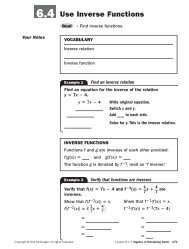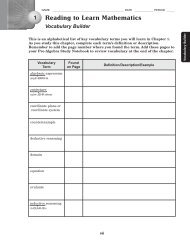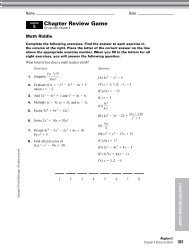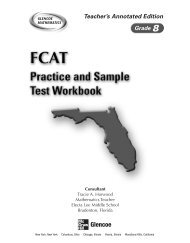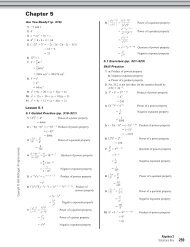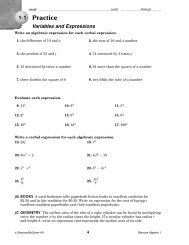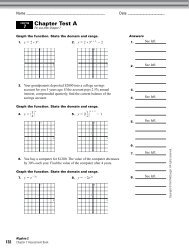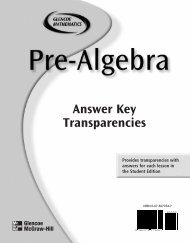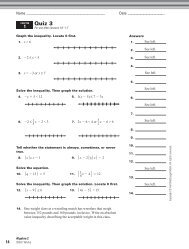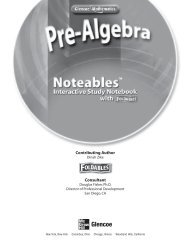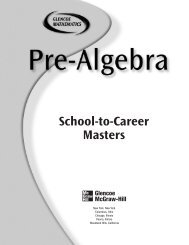Study Guide and Intervention (continued) - MathnMind
Study Guide and Intervention (continued) - MathnMind
Study Guide and Intervention (continued) - MathnMind
You also want an ePaper? Increase the reach of your titles
YUMPU automatically turns print PDFs into web optimized ePapers that Google loves.
4-2<br />
NAME ______________________________________________ DATE ____________ PERIOD _____<br />
<strong>Study</strong> <strong>Guide</strong> <strong>and</strong> <strong>Intervention</strong> (<strong>continued</strong>)<br />
Transformations on the Coordinate Plane<br />
Transform Figures on the Coordinate Plane You can perform transformations<br />
on a coordinate plane by changing the coordinates of each vertex. The vertices of the image<br />
of the transformed figure are indicated by the symbol , which is read prime.<br />
Reflection over x-axis (x, y) → (x, y)<br />
Reflection over y-axis (x, y) → (x, y)<br />
Translation (x, y) → (x a, y b)<br />
Dilation (x, y) → (kx, ky)<br />
Rotation 90 counterclockwise (x, y) → (y, x)<br />
Rotation 180 (x, y) → (x, y)<br />
Example<br />
A triangle has vertices A(1, 1), B(2, 4), <strong>and</strong> C(3, 0). Find the<br />
coordinates of the vertices of each image below.<br />
a. reflection over the x-axis<br />
To reflect a point over the x-axis,<br />
multiply the y-coordinate by 1.<br />
A(1, 1) → A(1, 1)<br />
B(2, 4) → B(2, 4)<br />
C(3, 0) → C(3, 0)<br />
The coordinates of the image vertices are<br />
A(1, 1), B(2, 4), <strong>and</strong> C(3, 0).<br />
Exercises<br />
b. dilation with a scale factor of 2<br />
Find the coordinates of the dilated figure<br />
by multiplying the coordinates by 2.<br />
A(1, 1) → A(2, 2)<br />
B(2, 4) → B(4, 8)<br />
C(3, 0) → C(6, 0)<br />
The coordinates of the image vertices are<br />
A(2, 2), B(4, 8), <strong>and</strong> C(6, 0).<br />
Find the coordinates of the vertices of each figure after the given transformation<br />
is performed.<br />
1. triangle RST with R(2, 4), S(2, 0), T(1, 1) reflected over the y-axis<br />
2. triangle ABC with A(0, 0), B(2, 4), C(3, 0) rotated about the origin 180°<br />
3. parallelogram ABCD with A(3, 0), B(2, 3), C(3, 3), D(2, 0) translated 3 units down<br />
4. quadrilateral RSTU with R(2, 2), S(2, 4), T(4, 4), U(4, 0) dilated by a factor of<br />
5. triangle ABC with A(4, 0), B(2, 3), C(0, 0) rotated counterclockwise 90°<br />
6. hexagon ABCDEF with A(0, 0), B(2, 3), C(0, 4), D(3, 4), E(4, 2), F(3, 0) translated<br />
2 units up <strong>and</strong> 1 unit to the left<br />
© Glencoe/McGraw-Hill 220 Glencoe Algebra 1<br />
1<br />
2



